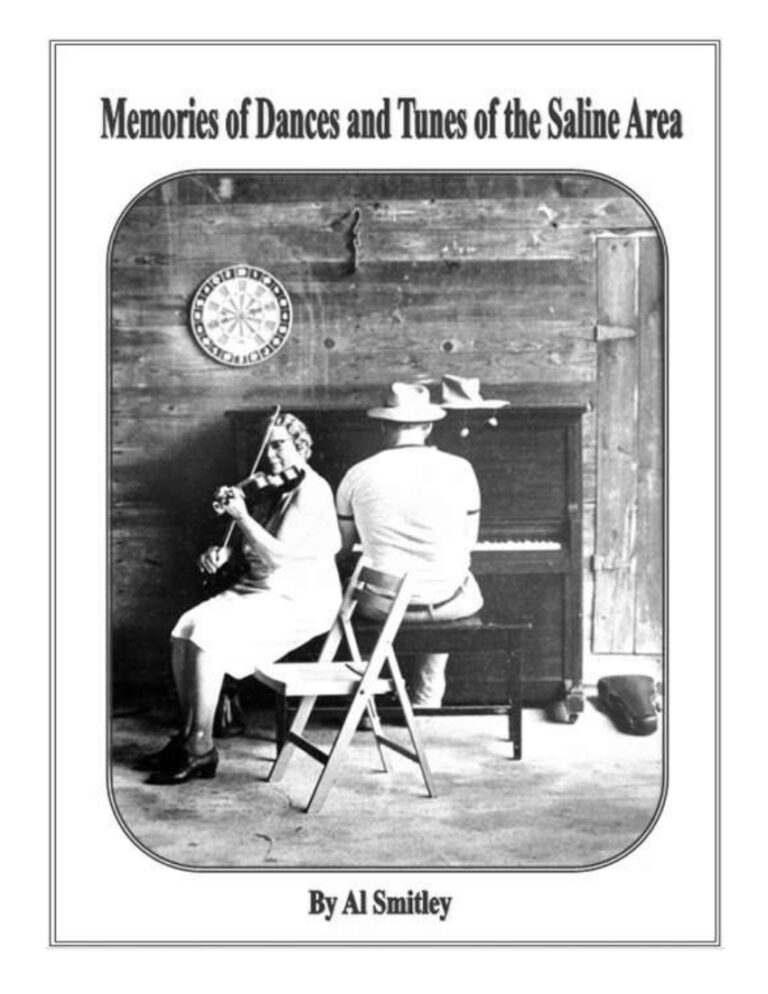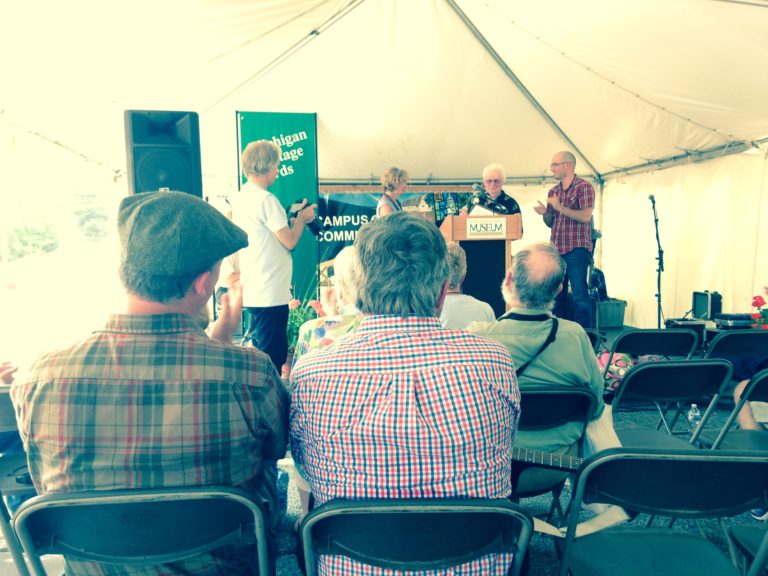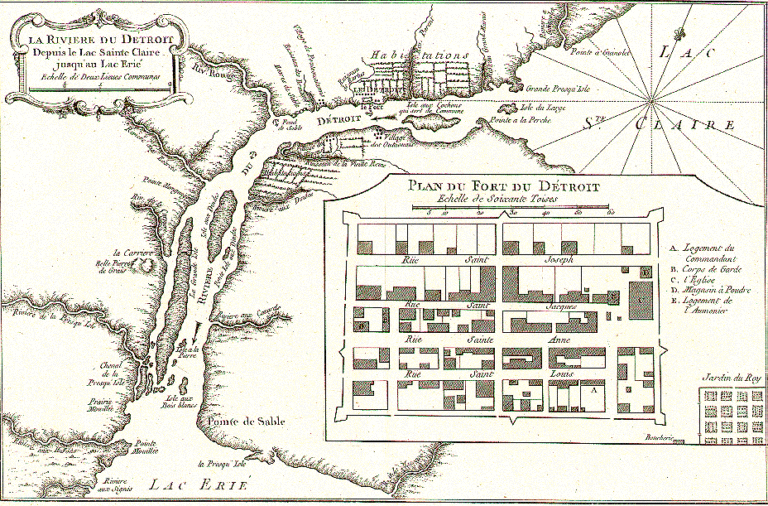Source:
History of Saginaw county from the year 1819 down to the present time. Comp. from authentic records and other sources: traditionary accounts, legends, anecdotes, &c., with valuable statistics, and notes of its resources, and general information concerning its advantages: also a business directory of each of the three principal towns in the county. Pages 73-74.
Commentary:
The fiddle was present throughout frontier life: at wakes, weddings, births, dancings, workings — and at theft and fraud. It is no surprise that while nativ e peoples were being cheated or coerced, the fiddle was present.
Excerpt:
“INDIAN PAYMENT DAY IN OLD TIMES. There is a vast sight of difference in the Indian payment day of the present, and that of the ” olden time “-long before Saginaw had attained to its present importance and standing. The writer of this had occasion to visit Saginaw City many years ago, at which time he had an opportunity of attending an Indian payment. About twelve hundred Indians of all ” sorts and sizes,” from the toddling papoose to the swarthy niche-nah-ba, were assembled together in the morning, upon the beautiful lawn which gently sloped toward the river in front of the council house. It would be almost impossible to give the reader an idea of the hubbub and ” confusion of tongues ” that prevailed upon the occasion. Aside from the twelve hundred Indians, were a variety of other characters, including the chattering Frenchman, the blarneying Irishman and the blubbering Dutchman, all mingling their discordant jargon with that of the vociferous Yankee. Groups of Indian boys, some exercising with the bow and arrow, others jumping, running, wrestling, and making the welkin ring with their noisy merriment, were collected in the vicinity of their respective tents.
The river, too, was covered with canoes, and here the ” dusky maid” in a more quiet and becoming manner, was enjoying the occasion; and it was really surprising to see the dexterity and fearlessness with which she managed the ” light canoe.” A list of all the names of the heads of Indian families, Chiefs, &c., was taken by the Indian Superintendent-each Indian being entitled to a certain amount. The money to be paid, was placed upon a table in the council room, in piles of ten and twenty dollars each, in American halfdollar pieces. Around the table sat the Indian Superintendent, Interpreter, Clerks, &c. Commencing at the top of the list, a crier called off the names, the owners of which presenting themselves, were paid off, and immediately made room for others. It was amusing to observe the great number of friends that would gather around the Indian after te received his money from the paymaster. Here a trader suddenly recollects some debt of long standing against Mr. Indian-there a seedy individual with eyes and nasal promontory coleur de pinque, most seductively offering him a drink of river water slightly tinctured with poor whiskey, while one or two dear friends are advising him to look out for sharpers, at the same time intimating that the Superintendent has been paying off in bogus coin!
In the evening, while the drinking Indians were rioting and carousing in the town, the evangelised natives were encamped upon the opposite side of the river, and the surrounding forest fairly resounded with their loud singing, preaching and praying. Instrumental music, from the fiddle to the Indian tattoo, might also have been heard arising above the ” horrid din.”
The scene that presents itself at an Indian payment now-a-days, is altogether a different one, at least at Saginaw City. We are happy to see measures adopted to prevent the sale of intoxicating drinks to the poor Indian upon such occasions-would to God it might be prohibited upon all occasions.”
Source:
History of Michigan, by Charles Moore. Pages 331-332.
Commentary:
Liquor was immensely important on the frontier. Trading companies used incredible quantities of it to cheat and control native people. This was not always legal.
Here we also hear the name of an early Saginaw fiddler, “Uncle Jimmy Cronk.” The title of “uncle” is a common one among fiddlers.
Excerpt:
“The Saginaw region long continued to be an Indian headquarters and a station of the American Fur Company was established there. As late as 1834 Saginaw could boast of only one tavern, and that one had but a single bedroom. Two rows of cots were placed in the attic, and when there were women among the guests they went first to bed. When the company’s little sloop Savage brought supplies from Detroit, the bluff old customs officer would repair on board and after a visit to the cabin would come up, smacking his lips, to give the requisite permission to land the goods. The same night a tap at his back door would be followed by the appearance of several demijohns containing the finest qualities of liquors. To the credit of the official it should be said that when the “leading families” of Saginaw gave their dancing parties they were always at liberty to send around after a demijohn, just as they would send for “Uncle Jimmy” Cronk to trudgethirty miles through the woods to fiddle for the dancing.”
Source:
History of Saginaw County, Michigan; historical, commercial, biographical, profusely illustrated with portraits of early pioneers, rare pictures and scenes of olden times, and portraits of representative citizens of today. Pages 138-139.
Commentary:
Here we find out more about the life of early Saginaw fiddler, Uncle Jimmy. It is interesting that Uncle Jimmy liked to play, according to this account, only at such dances.
Excerpt:
“Uncle Jimmy”, the Fiddler
But it must not be supposed that drinking bouts, or Saginaw “trains” as they were usually termed, were the only form of conviviality indulged in by the early settlers. During the long months of winter they often had dances, and when one was all arranged to be held at the house of Mrs. G. D. Williams, Mrs. E. N. Davenport, Mrs. James Fraser, Mrs. Eleazer Jewett, or others, a messenger was dispatched through the woods some thirty miles to the cabin of James W. Cronk, to notify him that his services as “fiddler”, were required at such a time. There were other persons nearer by who could supply the music for such occasions very acceptably, but the old citizens of Saginaw were too aristocratic to have any one play for them but their old friend and pioneer, “Uncle Jimmy”, who always at the appointed time put in an appearance with a fiddle-box under his arm and his rifle over his shoulder. These were the only parties the old fellow would condescend to play for, but he never failed his old friends, and no one contributed so much to the enjoyment of the evening as he. James WV. Cronk afterwards volunteered in the Mexican war and received a captain’s commission. He died some time after, together with his son, Norton, of yellow fever, at Vera Cruz, Mexico, deeply regretted by all the early pioneers. He was a man of more than ordinary ability, and one of the most genial of companions, as well as a great favorite among his associates.”
Source:
History of Saginaw County, Michigan; historical, commercial, biographical, profusely illustrated with portraits of early pioneers, rare pictures and scenes of olden times, and portraits of representative citizens of today. Page 181.
Commentary:
This excerpt comes from a later period of Saginaw history, roughly the 1850s. The mention of a harpist with the fiddler in this passage is interesting. I have suspicions that it may refer to a hammered dulcimer, but it may well have been an actual harp.
Excerpt:
“But in the winter we had a jolly good time, the few of us that were here. The young fellows would hire the hotel dining room for the evening, then go around and get their girls and until 12 o’clock there would be a good time. Tom Willey was the fiddler and Joe Hatzel the harpist. Those who came from the other side crossed the river by means of a scow, pulled by a rope with an old German, named Fritz, as the man power. A pioneer of those days can recall any number of interesting events of early Saginaw.”
Source:
History of Saginaw County, Michigan; historical, commercial, biographical, profusely illustrated with portraits of early pioneers, rare pictures and scenes of olden times, and portraits of representative citizens of today. Page 409.
Commentary:
The magic lantern was a type of image projector.
Excerpt:
“In 1843 James C. Fuller came to Chesaning and soon after purchased a farm and erected a log cabin in which he lived alone during the Winter of 1843-4. In the following Spring he was employed by George W. Chapman and lived on his farm for about two years. In the Summer of 1845 he built a house on the river bank on the east side of the village, and about the time it was finished the first show ever exhibiting in Chesaning came to the village. It was in his house that the few settlers assembled to view the magic lantern show, after which a fiddler from Owosso furnished music for a dance.”
Source:
Indian and pioneer history of the Saginaw Valley : with histories of East Saginaw, Saginaw City, and Bay City, from their earliest settlements, also pioneer directory and business advertiser for 1866 and 1867. Page 19.
Commentary:
This is a mention of perhaps the most repeated incident of Saginaw fiddle history; the drowning of Archie Lyons. Archie was a trading post agent, and on his way via ice skates to fiddle at a party, he was drowned.
Excerpt:
“Archie Lyons was another trustworthy agent of the Messrs. Williams, whose history is identified with the Saginaw Valley prior to the Treaty. He was a fine penman well educated and a inusician of no little skill. He was located at the little Forks of the Tittabawassee (Midland City) and in coming down fron that point, on the ice, upon skates, for the purpose of playing the violin for a dancing party at Saginaw City he was drowned. His track was found upon the ice the next day, to the edge of the hole into which he had skated, leaving no doubt as to his fate. His, widow, a bright and agreeable woman, of French and Indian extraction, who rejoiced in the almost unpronouncable name of Ka-ze-zhe-ah-be-no-qua, became afterwards the wife of Antoine Peltier of Pine-ne-con-ning; a second marriage that was undoubtedly justifiable if her object was to free herself from her most remarkable Indian name.”
Source:
History of Genesee county, Michigan. With illustrations and biographical sketches of its prominent men and pioneers. Page 28.
Commentary:
Here is another account of the accident.
Excerpt:
“Archie Lyons was a trustworthy agent of the Messrs. Williams [Gardner D. and Ephraim S. Williams, traders at Saginaw, and on the Tittabawassee], whose history is identified with the Saginaw Valley prior to the treaty. He was a fine penman, well educated, and a musician of no little skill. He was located at the Little Forks of the Tittabawassee (Midland City), and in coming down from that point on the ice upon skates for the purpose of playing the violin for a dancing-party at Saginaw he was drowned. His track was found on the ice the next day, to the edge of the hole into which he had skated, leaving no doubt as to his fate.” ?Io,. C. P. Avery. “
Source:
History of Saginaw County, Michigan; historical, commercial, biographical, profusely illustrated with portraits of early pioneers, rare pictures and scenes of olden times, and portraits of representative citizens of today. Page 93.
Commentary:
Another account, very similar to the first, from a different source. There is another besides this, but it is so similar as to not bear repeating yet again.
Excerpt:
“Another trusted agent, who was identified with the history of the valley before the treaty of 1819, was Archie Lyons. He was a fine penman, well educated, and was a musician of skill, playing the violin very effectively. He lived at the Little Forks of the Tittabawassee, now known as Midland. and in skating down on the ice one winter’s day, for the purpose of playing for a dancing party, he was drowned. His tracks were found upon the ice next day, to the edge of a hole into which he had plunged. His widow, a bright and agreeable woman of French and Indian extraction, who formerly had an almost unpronouncalble name of Ka-ze-zhe-ah-be-no-qua, afterward married Antoine Peltier, of Pine-ne-con-ning, again freeing herself from a remarkable Indian name.”



